BAC705 Auditing: Strategic Risk Assessment of LQFL, Semester 1, 2019
VerifiedAdded on 2023/03/30
|19
|3004
|344
Case Study
AI Summary
This case study presents an audit of Lucy’s Quality Foods Limited (LQFL), focusing on strategic business risk assessment using PEST analysis, evaluation of internal controls, and financial statement analysis. It assesses inherent risks, risks of material misstatement, and conducts horizontal and vertical analysis of financial statements, including profitability, liquidity, and solvency ratios. The analysis reveals strengths and weaknesses in LQFL's financial performance and risk management, providing insights into the company's ability to handle economic changes and maintain effective internal controls. Desklib offers similar solved assignments and resources for students.
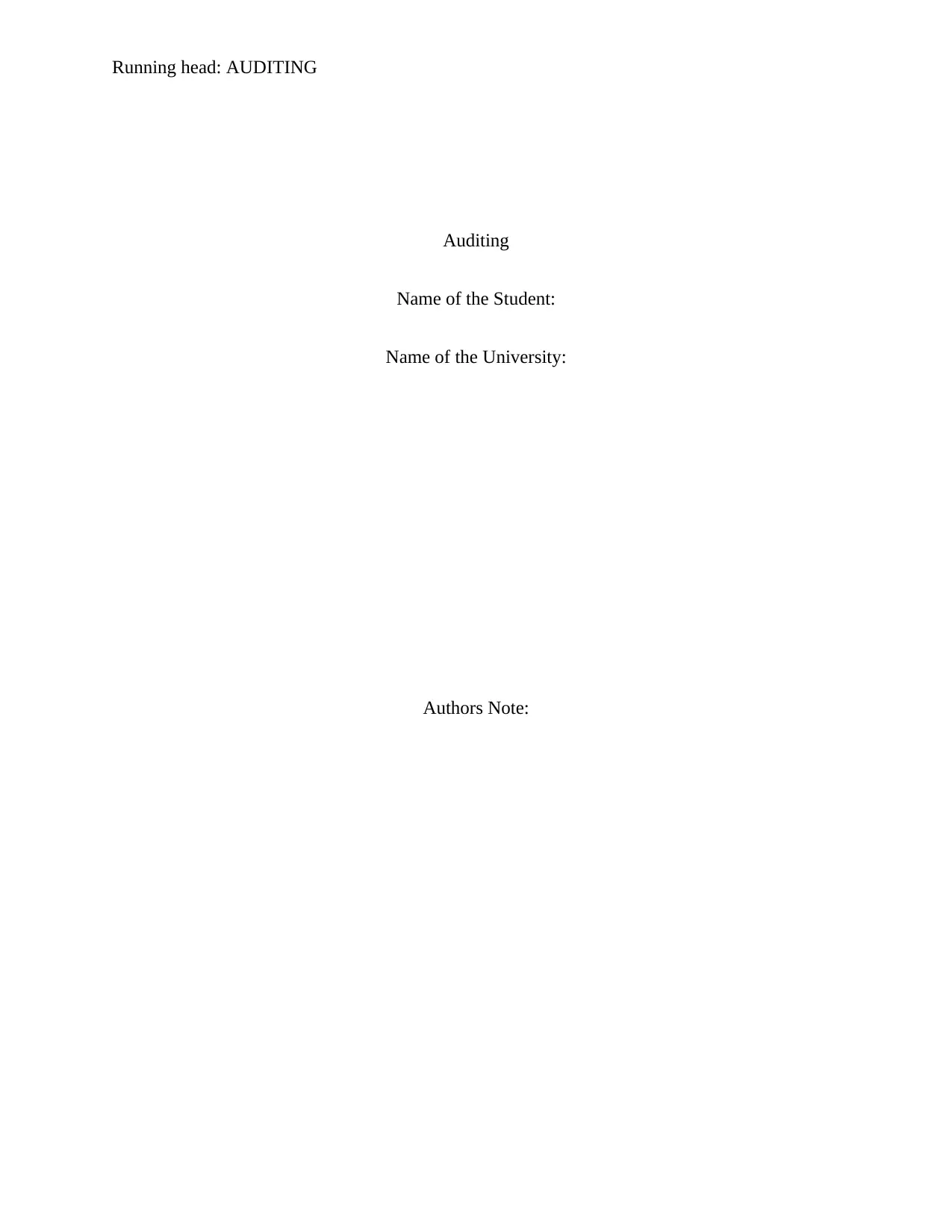
Running head: AUDITING
Auditing
Name of the Student:
Name of the University:
Authors Note:
Auditing
Name of the Student:
Name of the University:
Authors Note:
Paraphrase This Document
Need a fresh take? Get an instant paraphrase of this document with our AI Paraphraser
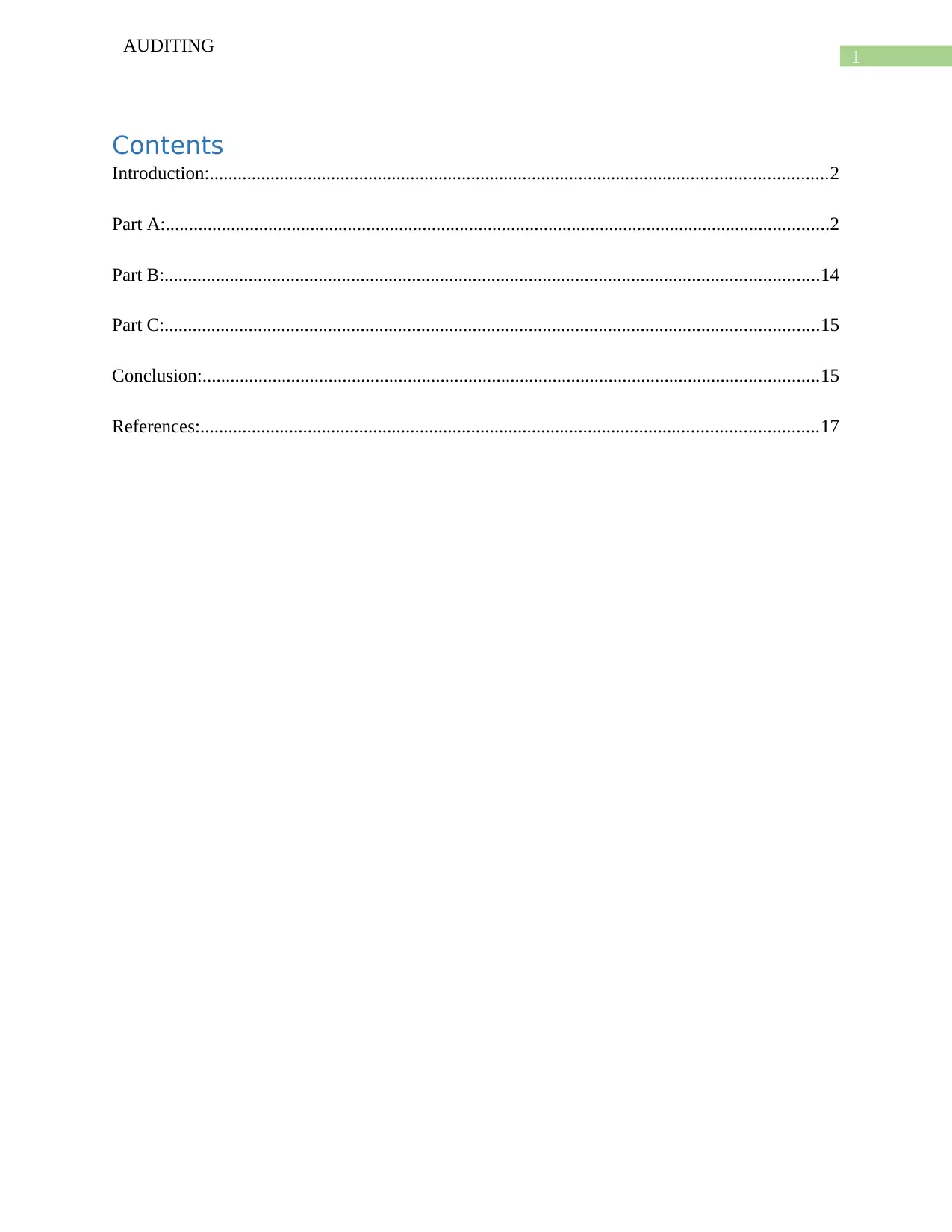
1
AUDITING
Contents
Introduction:....................................................................................................................................2
Part A:..............................................................................................................................................2
Part B:............................................................................................................................................14
Part C:............................................................................................................................................15
Conclusion:....................................................................................................................................15
References:....................................................................................................................................17
AUDITING
Contents
Introduction:....................................................................................................................................2
Part A:..............................................................................................................................................2
Part B:............................................................................................................................................14
Part C:............................................................................................................................................15
Conclusion:....................................................................................................................................15
References:....................................................................................................................................17
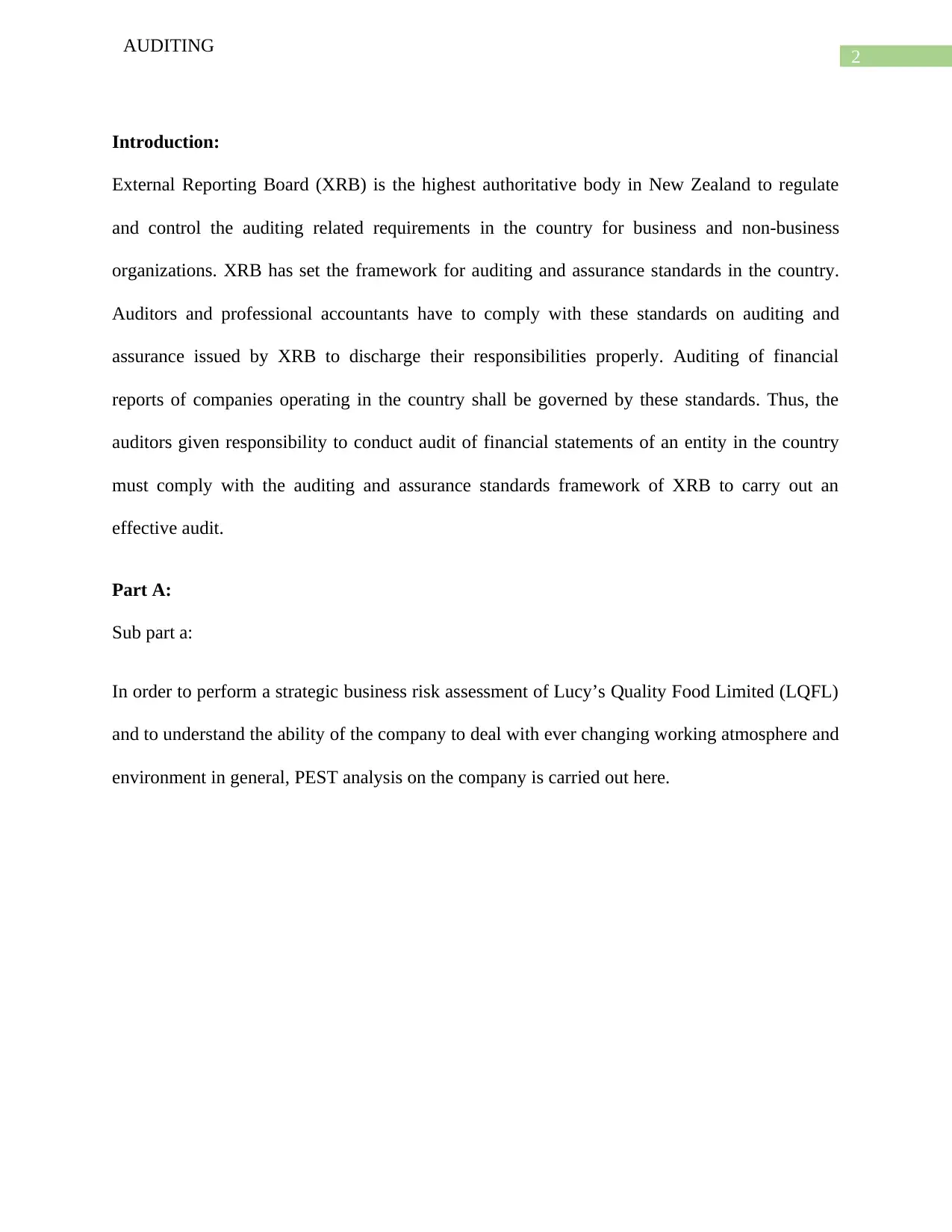
2
AUDITING
Introduction:
External Reporting Board (XRB) is the highest authoritative body in New Zealand to regulate
and control the auditing related requirements in the country for business and non-business
organizations. XRB has set the framework for auditing and assurance standards in the country.
Auditors and professional accountants have to comply with these standards on auditing and
assurance issued by XRB to discharge their responsibilities properly. Auditing of financial
reports of companies operating in the country shall be governed by these standards. Thus, the
auditors given responsibility to conduct audit of financial statements of an entity in the country
must comply with the auditing and assurance standards framework of XRB to carry out an
effective audit.
Part A:
Sub part a:
In order to perform a strategic business risk assessment of Lucy’s Quality Food Limited (LQFL)
and to understand the ability of the company to deal with ever changing working atmosphere and
environment in general, PEST analysis on the company is carried out here.
AUDITING
Introduction:
External Reporting Board (XRB) is the highest authoritative body in New Zealand to regulate
and control the auditing related requirements in the country for business and non-business
organizations. XRB has set the framework for auditing and assurance standards in the country.
Auditors and professional accountants have to comply with these standards on auditing and
assurance issued by XRB to discharge their responsibilities properly. Auditing of financial
reports of companies operating in the country shall be governed by these standards. Thus, the
auditors given responsibility to conduct audit of financial statements of an entity in the country
must comply with the auditing and assurance standards framework of XRB to carry out an
effective audit.
Part A:
Sub part a:
In order to perform a strategic business risk assessment of Lucy’s Quality Food Limited (LQFL)
and to understand the ability of the company to deal with ever changing working atmosphere and
environment in general, PEST analysis on the company is carried out here.
⊘ This is a preview!⊘
Do you want full access?
Subscribe today to unlock all pages.

Trusted by 1+ million students worldwide
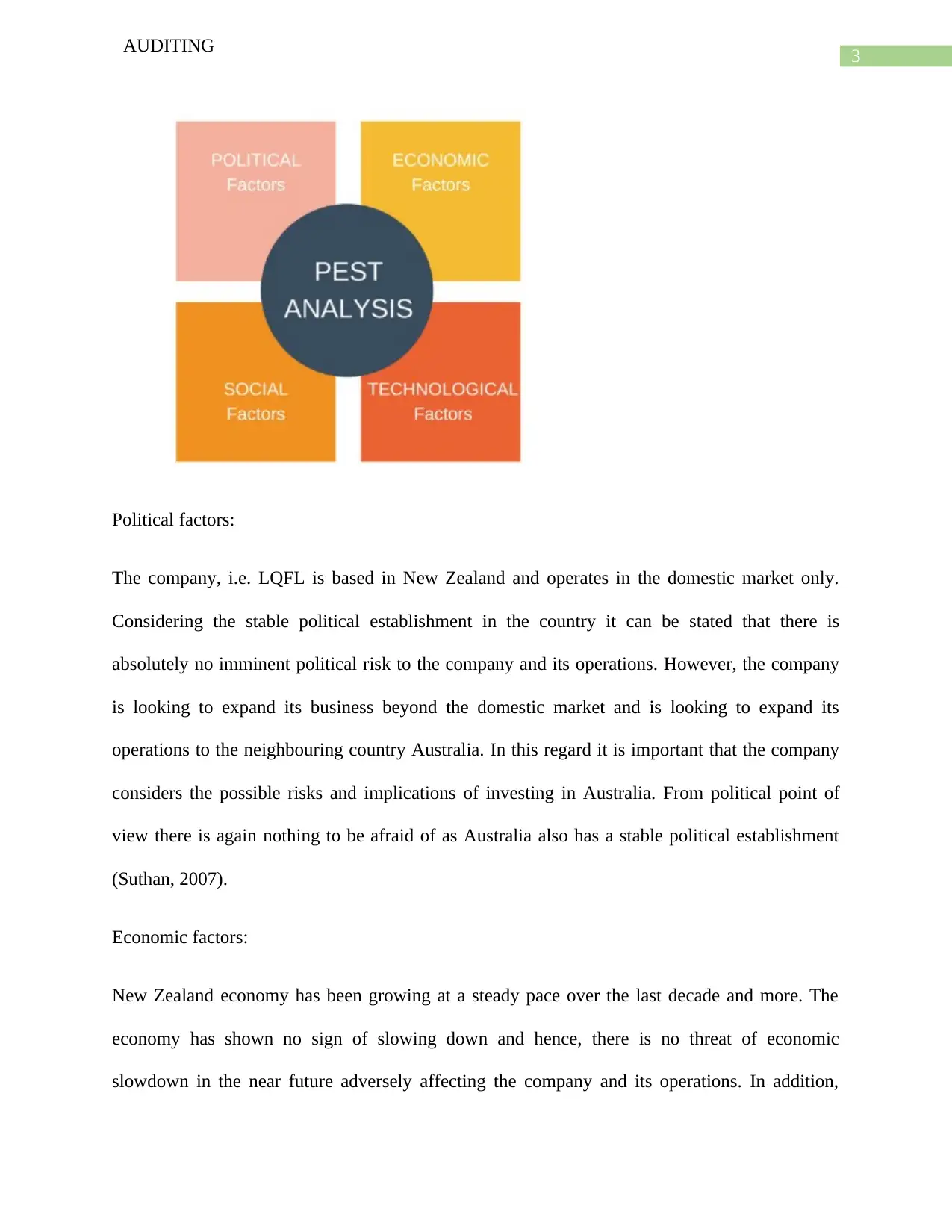
3
AUDITING
Political factors:
The company, i.e. LQFL is based in New Zealand and operates in the domestic market only.
Considering the stable political establishment in the country it can be stated that there is
absolutely no imminent political risk to the company and its operations. However, the company
is looking to expand its business beyond the domestic market and is looking to expand its
operations to the neighbouring country Australia. In this regard it is important that the company
considers the possible risks and implications of investing in Australia. From political point of
view there is again nothing to be afraid of as Australia also has a stable political establishment
(Suthan, 2007).
Economic factors:
New Zealand economy has been growing at a steady pace over the last decade and more. The
economy has shown no sign of slowing down and hence, there is no threat of economic
slowdown in the near future adversely affecting the company and its operations. In addition,
AUDITING
Political factors:
The company, i.e. LQFL is based in New Zealand and operates in the domestic market only.
Considering the stable political establishment in the country it can be stated that there is
absolutely no imminent political risk to the company and its operations. However, the company
is looking to expand its business beyond the domestic market and is looking to expand its
operations to the neighbouring country Australia. In this regard it is important that the company
considers the possible risks and implications of investing in Australia. From political point of
view there is again nothing to be afraid of as Australia also has a stable political establishment
(Suthan, 2007).
Economic factors:
New Zealand economy has been growing at a steady pace over the last decade and more. The
economy has shown no sign of slowing down and hence, there is no threat of economic
slowdown in the near future adversely affecting the company and its operations. In addition,
Paraphrase This Document
Need a fresh take? Get an instant paraphrase of this document with our AI Paraphraser
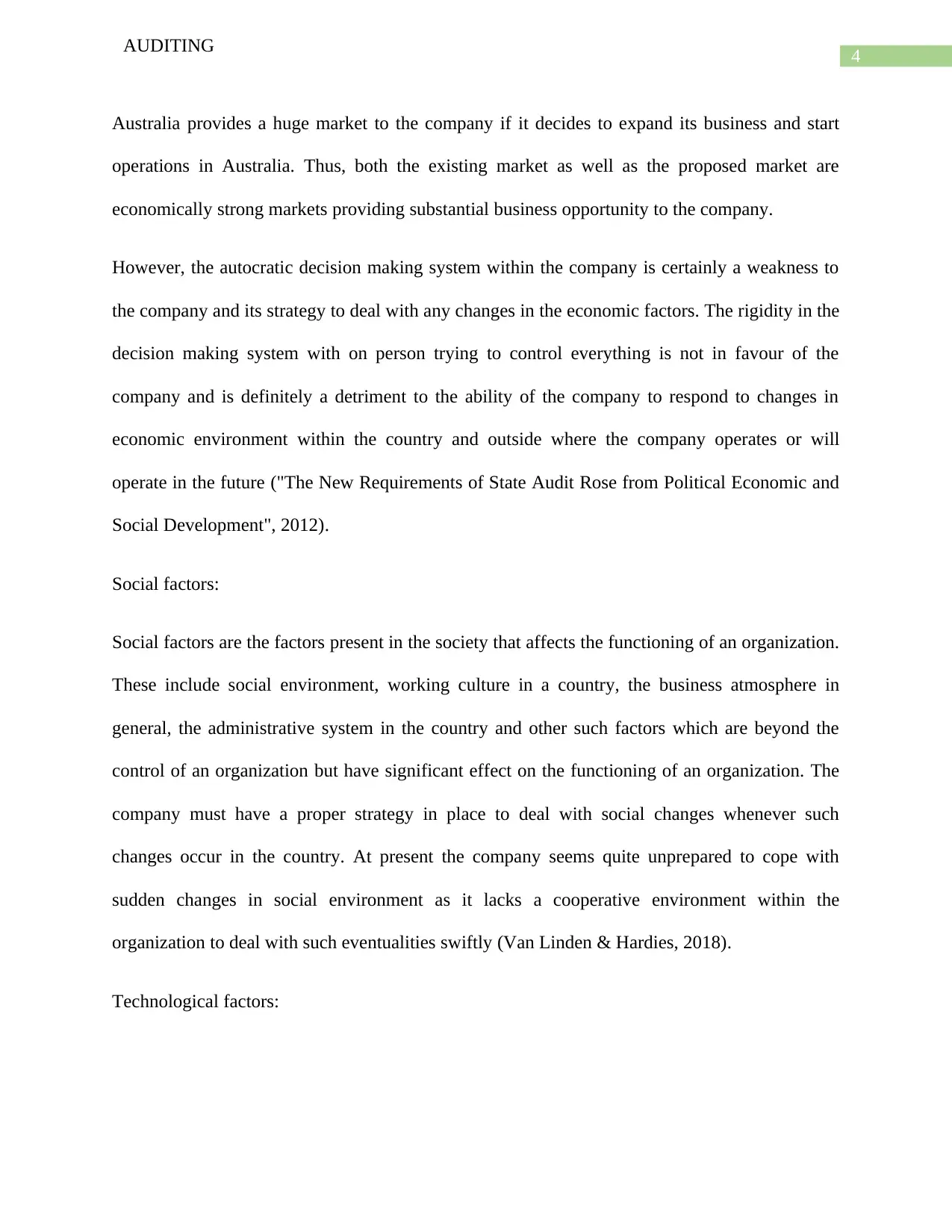
4
AUDITING
Australia provides a huge market to the company if it decides to expand its business and start
operations in Australia. Thus, both the existing market as well as the proposed market are
economically strong markets providing substantial business opportunity to the company.
However, the autocratic decision making system within the company is certainly a weakness to
the company and its strategy to deal with any changes in the economic factors. The rigidity in the
decision making system with on person trying to control everything is not in favour of the
company and is definitely a detriment to the ability of the company to respond to changes in
economic environment within the country and outside where the company operates or will
operate in the future ("The New Requirements of State Audit Rose from Political Economic and
Social Development", 2012).
Social factors:
Social factors are the factors present in the society that affects the functioning of an organization.
These include social environment, working culture in a country, the business atmosphere in
general, the administrative system in the country and other such factors which are beyond the
control of an organization but have significant effect on the functioning of an organization. The
company must have a proper strategy in place to deal with social changes whenever such
changes occur in the country. At present the company seems quite unprepared to cope with
sudden changes in social environment as it lacks a cooperative environment within the
organization to deal with such eventualities swiftly (Van Linden & Hardies, 2018).
Technological factors:
AUDITING
Australia provides a huge market to the company if it decides to expand its business and start
operations in Australia. Thus, both the existing market as well as the proposed market are
economically strong markets providing substantial business opportunity to the company.
However, the autocratic decision making system within the company is certainly a weakness to
the company and its strategy to deal with any changes in the economic factors. The rigidity in the
decision making system with on person trying to control everything is not in favour of the
company and is definitely a detriment to the ability of the company to respond to changes in
economic environment within the country and outside where the company operates or will
operate in the future ("The New Requirements of State Audit Rose from Political Economic and
Social Development", 2012).
Social factors:
Social factors are the factors present in the society that affects the functioning of an organization.
These include social environment, working culture in a country, the business atmosphere in
general, the administrative system in the country and other such factors which are beyond the
control of an organization but have significant effect on the functioning of an organization. The
company must have a proper strategy in place to deal with social changes whenever such
changes occur in the country. At present the company seems quite unprepared to cope with
sudden changes in social environment as it lacks a cooperative environment within the
organization to deal with such eventualities swiftly (Van Linden & Hardies, 2018).
Technological factors:
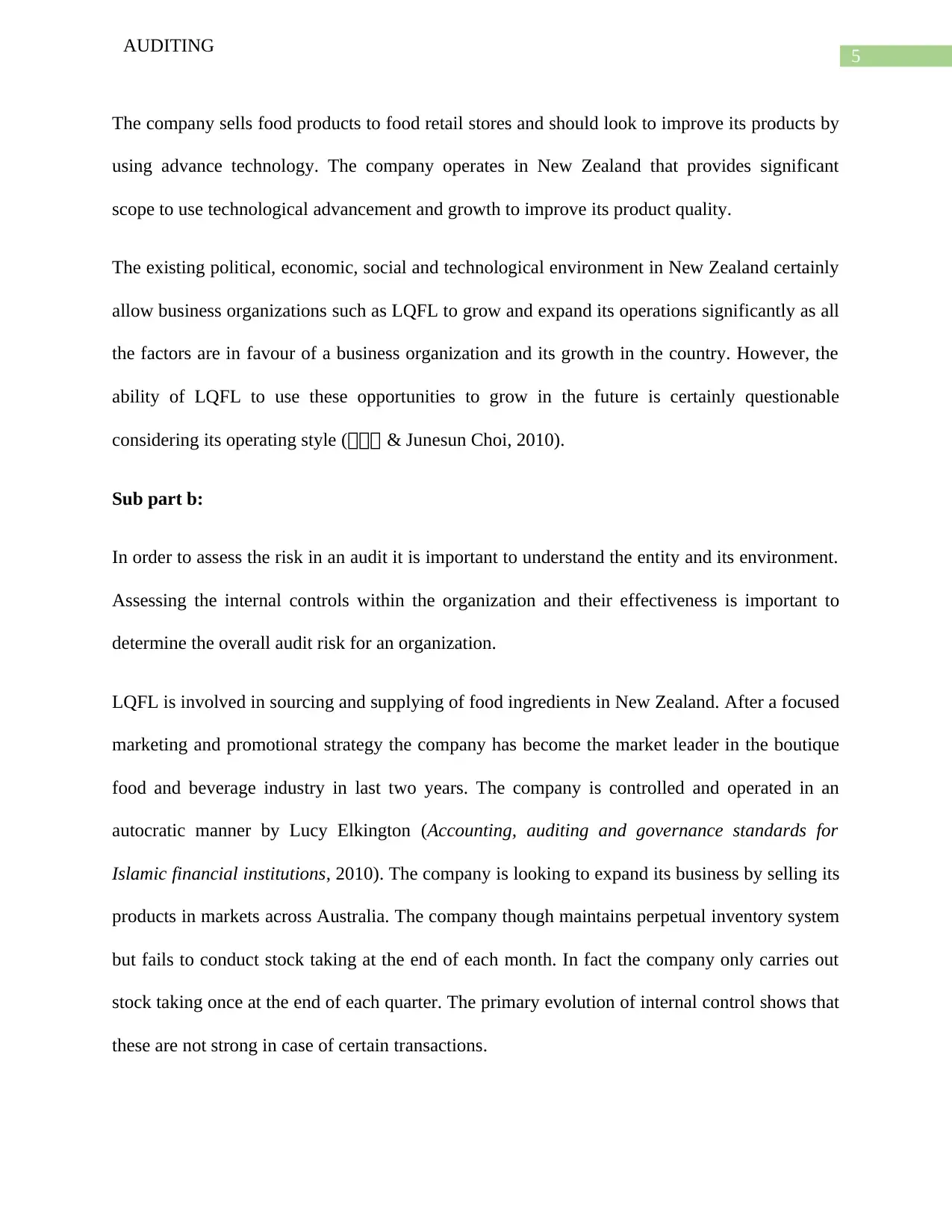
5
AUDITING
The company sells food products to food retail stores and should look to improve its products by
using advance technology. The company operates in New Zealand that provides significant
scope to use technological advancement and growth to improve its product quality.
The existing political, economic, social and technological environment in New Zealand certainly
allow business organizations such as LQFL to grow and expand its operations significantly as all
the factors are in favour of a business organization and its growth in the country. However, the
ability of LQFL to use these opportunities to grow in the future is certainly questionable
considering its operating style (서서서 & Junesun Choi, 2010).
Sub part b:
In order to assess the risk in an audit it is important to understand the entity and its environment.
Assessing the internal controls within the organization and their effectiveness is important to
determine the overall audit risk for an organization.
LQFL is involved in sourcing and supplying of food ingredients in New Zealand. After a focused
marketing and promotional strategy the company has become the market leader in the boutique
food and beverage industry in last two years. The company is controlled and operated in an
autocratic manner by Lucy Elkington (Accounting, auditing and governance standards for
Islamic financial institutions, 2010). The company is looking to expand its business by selling its
products in markets across Australia. The company though maintains perpetual inventory system
but fails to conduct stock taking at the end of each month. In fact the company only carries out
stock taking once at the end of each quarter. The primary evolution of internal control shows that
these are not strong in case of certain transactions.
AUDITING
The company sells food products to food retail stores and should look to improve its products by
using advance technology. The company operates in New Zealand that provides significant
scope to use technological advancement and growth to improve its product quality.
The existing political, economic, social and technological environment in New Zealand certainly
allow business organizations such as LQFL to grow and expand its operations significantly as all
the factors are in favour of a business organization and its growth in the country. However, the
ability of LQFL to use these opportunities to grow in the future is certainly questionable
considering its operating style (서서서 & Junesun Choi, 2010).
Sub part b:
In order to assess the risk in an audit it is important to understand the entity and its environment.
Assessing the internal controls within the organization and their effectiveness is important to
determine the overall audit risk for an organization.
LQFL is involved in sourcing and supplying of food ingredients in New Zealand. After a focused
marketing and promotional strategy the company has become the market leader in the boutique
food and beverage industry in last two years. The company is controlled and operated in an
autocratic manner by Lucy Elkington (Accounting, auditing and governance standards for
Islamic financial institutions, 2010). The company is looking to expand its business by selling its
products in markets across Australia. The company though maintains perpetual inventory system
but fails to conduct stock taking at the end of each month. In fact the company only carries out
stock taking once at the end of each quarter. The primary evolution of internal control shows that
these are not strong in case of certain transactions.
⊘ This is a preview!⊘
Do you want full access?
Subscribe today to unlock all pages.

Trusted by 1+ million students worldwide
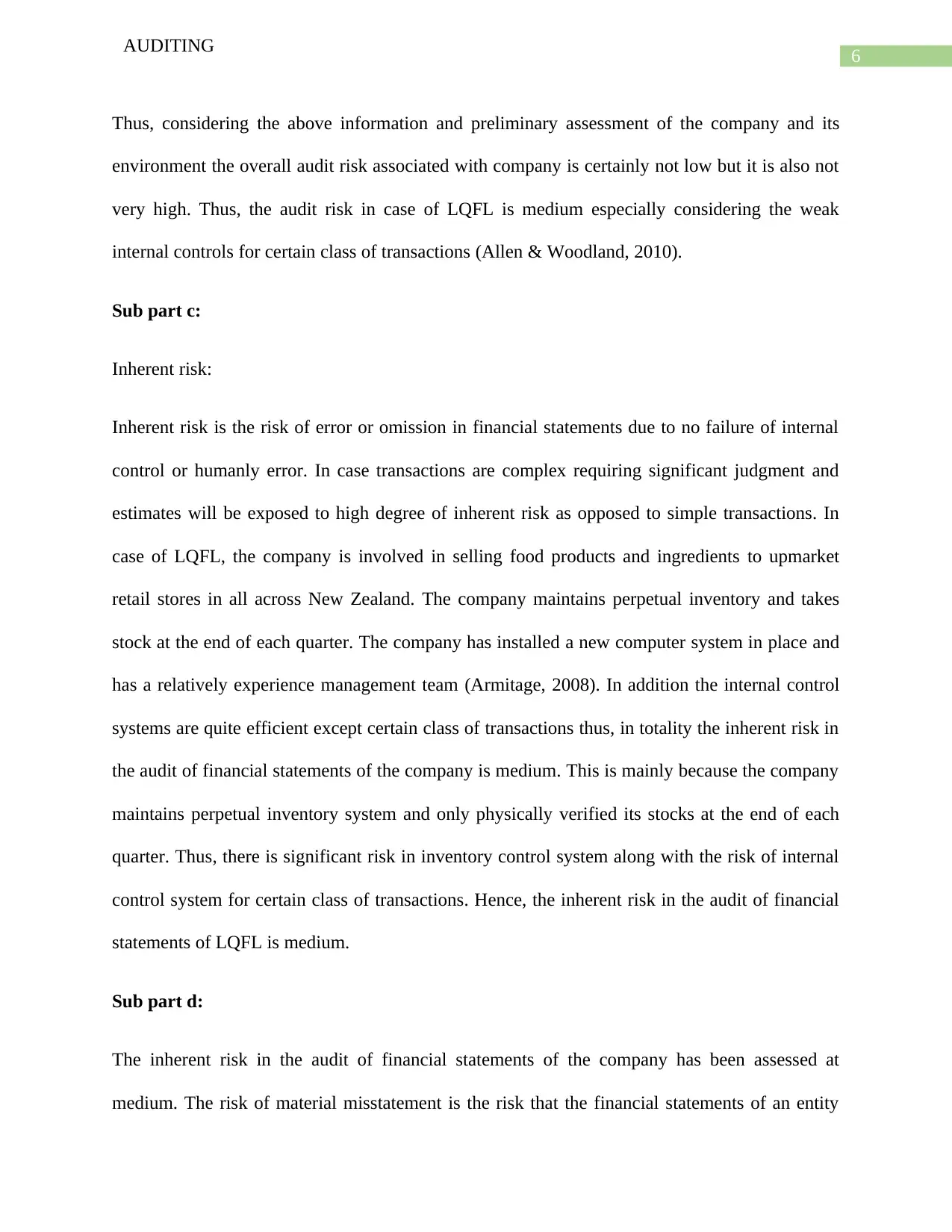
6
AUDITING
Thus, considering the above information and preliminary assessment of the company and its
environment the overall audit risk associated with company is certainly not low but it is also not
very high. Thus, the audit risk in case of LQFL is medium especially considering the weak
internal controls for certain class of transactions (Allen & Woodland, 2010).
Sub part c:
Inherent risk:
Inherent risk is the risk of error or omission in financial statements due to no failure of internal
control or humanly error. In case transactions are complex requiring significant judgment and
estimates will be exposed to high degree of inherent risk as opposed to simple transactions. In
case of LQFL, the company is involved in selling food products and ingredients to upmarket
retail stores in all across New Zealand. The company maintains perpetual inventory and takes
stock at the end of each quarter. The company has installed a new computer system in place and
has a relatively experience management team (Armitage, 2008). In addition the internal control
systems are quite efficient except certain class of transactions thus, in totality the inherent risk in
the audit of financial statements of the company is medium. This is mainly because the company
maintains perpetual inventory system and only physically verified its stocks at the end of each
quarter. Thus, there is significant risk in inventory control system along with the risk of internal
control system for certain class of transactions. Hence, the inherent risk in the audit of financial
statements of LQFL is medium.
Sub part d:
The inherent risk in the audit of financial statements of the company has been assessed at
medium. The risk of material misstatement is the risk that the financial statements of an entity
AUDITING
Thus, considering the above information and preliminary assessment of the company and its
environment the overall audit risk associated with company is certainly not low but it is also not
very high. Thus, the audit risk in case of LQFL is medium especially considering the weak
internal controls for certain class of transactions (Allen & Woodland, 2010).
Sub part c:
Inherent risk:
Inherent risk is the risk of error or omission in financial statements due to no failure of internal
control or humanly error. In case transactions are complex requiring significant judgment and
estimates will be exposed to high degree of inherent risk as opposed to simple transactions. In
case of LQFL, the company is involved in selling food products and ingredients to upmarket
retail stores in all across New Zealand. The company maintains perpetual inventory and takes
stock at the end of each quarter. The company has installed a new computer system in place and
has a relatively experience management team (Armitage, 2008). In addition the internal control
systems are quite efficient except certain class of transactions thus, in totality the inherent risk in
the audit of financial statements of the company is medium. This is mainly because the company
maintains perpetual inventory system and only physically verified its stocks at the end of each
quarter. Thus, there is significant risk in inventory control system along with the risk of internal
control system for certain class of transactions. Hence, the inherent risk in the audit of financial
statements of LQFL is medium.
Sub part d:
The inherent risk in the audit of financial statements of the company has been assessed at
medium. The risk of material misstatement is the risk that the financial statements of an entity
Paraphrase This Document
Need a fresh take? Get an instant paraphrase of this document with our AI Paraphraser
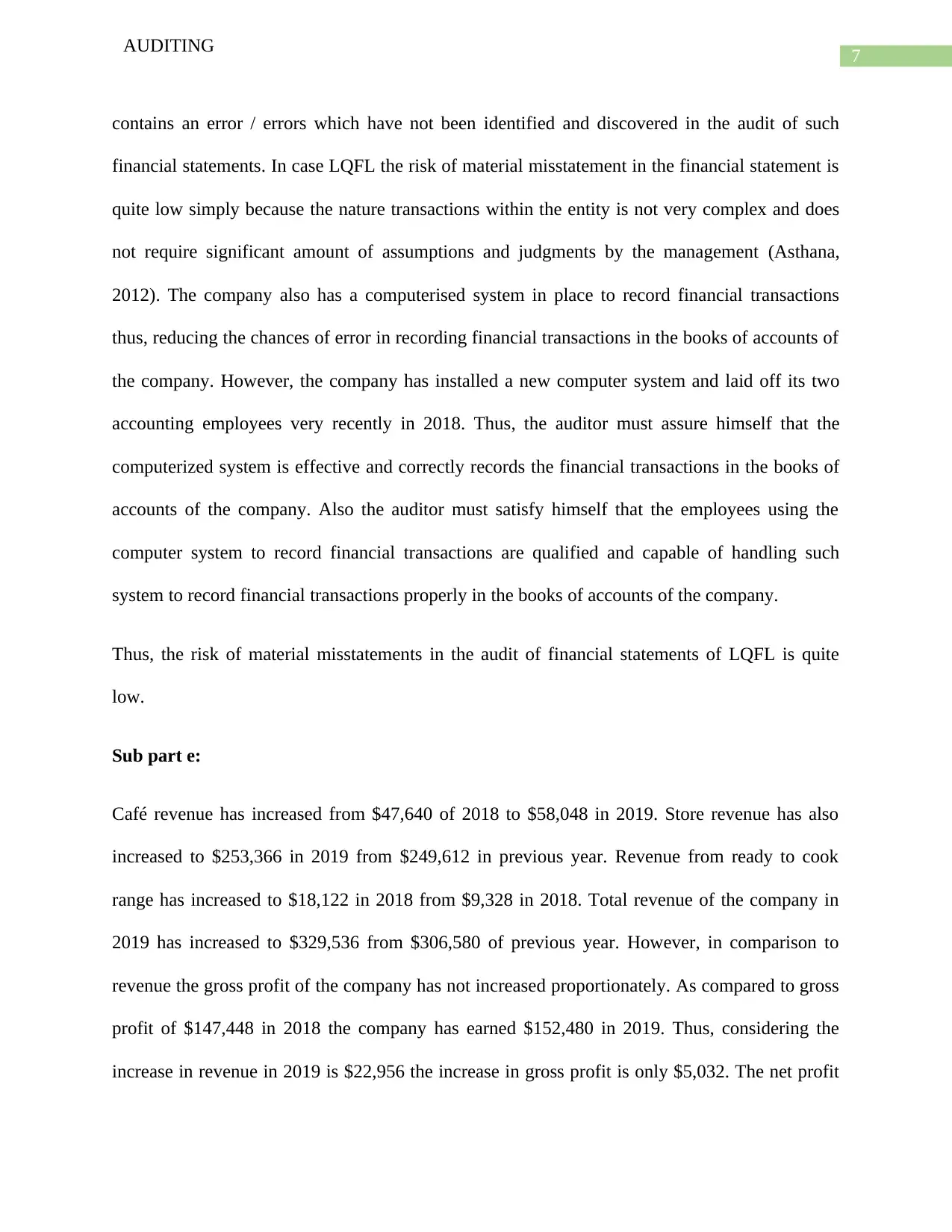
7
AUDITING
contains an error / errors which have not been identified and discovered in the audit of such
financial statements. In case LQFL the risk of material misstatement in the financial statement is
quite low simply because the nature transactions within the entity is not very complex and does
not require significant amount of assumptions and judgments by the management (Asthana,
2012). The company also has a computerised system in place to record financial transactions
thus, reducing the chances of error in recording financial transactions in the books of accounts of
the company. However, the company has installed a new computer system and laid off its two
accounting employees very recently in 2018. Thus, the auditor must assure himself that the
computerized system is effective and correctly records the financial transactions in the books of
accounts of the company. Also the auditor must satisfy himself that the employees using the
computer system to record financial transactions are qualified and capable of handling such
system to record financial transactions properly in the books of accounts of the company.
Thus, the risk of material misstatements in the audit of financial statements of LQFL is quite
low.
Sub part e:
Café revenue has increased from $47,640 of 2018 to $58,048 in 2019. Store revenue has also
increased to $253,366 in 2019 from $249,612 in previous year. Revenue from ready to cook
range has increased to $18,122 in 2018 from $9,328 in 2018. Total revenue of the company in
2019 has increased to $329,536 from $306,580 of previous year. However, in comparison to
revenue the gross profit of the company has not increased proportionately. As compared to gross
profit of $147,448 in 2018 the company has earned $152,480 in 2019. Thus, considering the
increase in revenue in 2019 is $22,956 the increase in gross profit is only $5,032. The net profit
AUDITING
contains an error / errors which have not been identified and discovered in the audit of such
financial statements. In case LQFL the risk of material misstatement in the financial statement is
quite low simply because the nature transactions within the entity is not very complex and does
not require significant amount of assumptions and judgments by the management (Asthana,
2012). The company also has a computerised system in place to record financial transactions
thus, reducing the chances of error in recording financial transactions in the books of accounts of
the company. However, the company has installed a new computer system and laid off its two
accounting employees very recently in 2018. Thus, the auditor must assure himself that the
computerized system is effective and correctly records the financial transactions in the books of
accounts of the company. Also the auditor must satisfy himself that the employees using the
computer system to record financial transactions are qualified and capable of handling such
system to record financial transactions properly in the books of accounts of the company.
Thus, the risk of material misstatements in the audit of financial statements of LQFL is quite
low.
Sub part e:
Café revenue has increased from $47,640 of 2018 to $58,048 in 2019. Store revenue has also
increased to $253,366 in 2019 from $249,612 in previous year. Revenue from ready to cook
range has increased to $18,122 in 2018 from $9,328 in 2018. Total revenue of the company in
2019 has increased to $329,536 from $306,580 of previous year. However, in comparison to
revenue the gross profit of the company has not increased proportionately. As compared to gross
profit of $147,448 in 2018 the company has earned $152,480 in 2019. Thus, considering the
increase in revenue in 2019 is $22,956 the increase in gross profit is only $5,032. The net profit
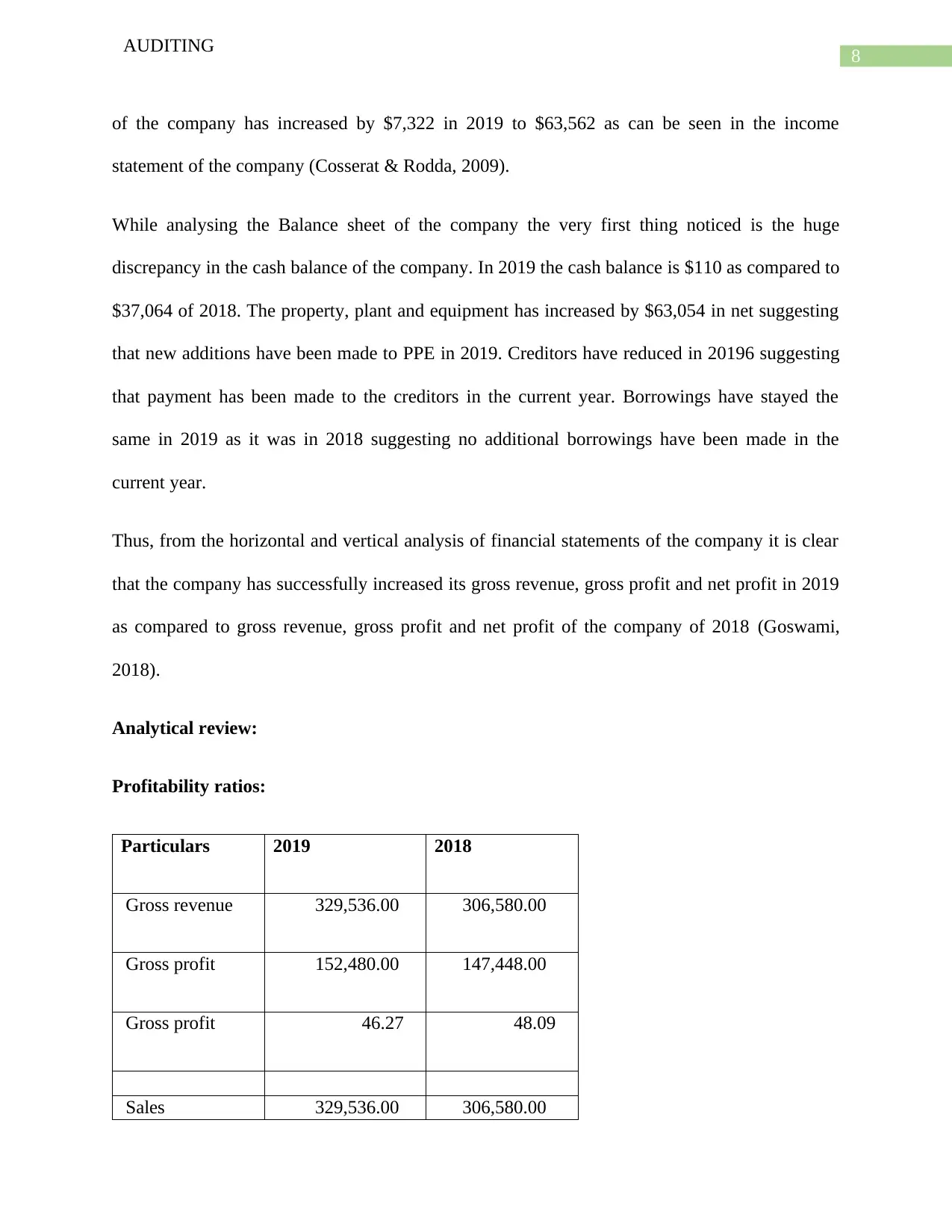
8
AUDITING
of the company has increased by $7,322 in 2019 to $63,562 as can be seen in the income
statement of the company (Cosserat & Rodda, 2009).
While analysing the Balance sheet of the company the very first thing noticed is the huge
discrepancy in the cash balance of the company. In 2019 the cash balance is $110 as compared to
$37,064 of 2018. The property, plant and equipment has increased by $63,054 in net suggesting
that new additions have been made to PPE in 2019. Creditors have reduced in 20196 suggesting
that payment has been made to the creditors in the current year. Borrowings have stayed the
same in 2019 as it was in 2018 suggesting no additional borrowings have been made in the
current year.
Thus, from the horizontal and vertical analysis of financial statements of the company it is clear
that the company has successfully increased its gross revenue, gross profit and net profit in 2019
as compared to gross revenue, gross profit and net profit of the company of 2018 (Goswami,
2018).
Analytical review:
Profitability ratios:
Particulars 2019 2018
Gross revenue 329,536.00 306,580.00
Gross profit 152,480.00 147,448.00
Gross profit 46.27 48.09
Sales 329,536.00 306,580.00
AUDITING
of the company has increased by $7,322 in 2019 to $63,562 as can be seen in the income
statement of the company (Cosserat & Rodda, 2009).
While analysing the Balance sheet of the company the very first thing noticed is the huge
discrepancy in the cash balance of the company. In 2019 the cash balance is $110 as compared to
$37,064 of 2018. The property, plant and equipment has increased by $63,054 in net suggesting
that new additions have been made to PPE in 2019. Creditors have reduced in 20196 suggesting
that payment has been made to the creditors in the current year. Borrowings have stayed the
same in 2019 as it was in 2018 suggesting no additional borrowings have been made in the
current year.
Thus, from the horizontal and vertical analysis of financial statements of the company it is clear
that the company has successfully increased its gross revenue, gross profit and net profit in 2019
as compared to gross revenue, gross profit and net profit of the company of 2018 (Goswami,
2018).
Analytical review:
Profitability ratios:
Particulars 2019 2018
Gross revenue 329,536.00 306,580.00
Gross profit 152,480.00 147,448.00
Gross profit 46.27 48.09
Sales 329,536.00 306,580.00
⊘ This is a preview!⊘
Do you want full access?
Subscribe today to unlock all pages.

Trusted by 1+ million students worldwide
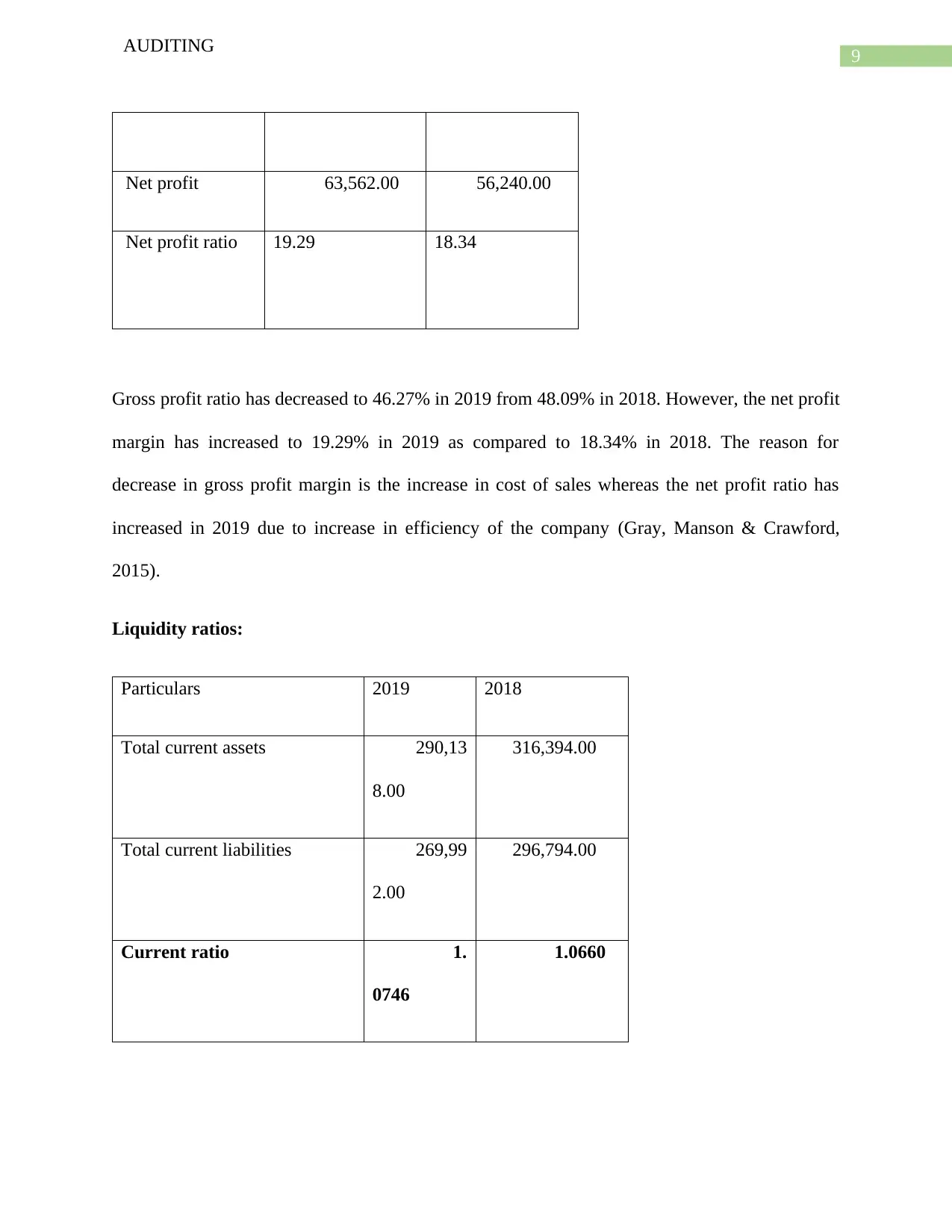
9
AUDITING
Net profit 63,562.00 56,240.00
Net profit ratio 19.29 18.34
Gross profit ratio has decreased to 46.27% in 2019 from 48.09% in 2018. However, the net profit
margin has increased to 19.29% in 2019 as compared to 18.34% in 2018. The reason for
decrease in gross profit margin is the increase in cost of sales whereas the net profit ratio has
increased in 2019 due to increase in efficiency of the company (Gray, Manson & Crawford,
2015).
Liquidity ratios:
Particulars 2019 2018
Total current assets 290,13
8.00
316,394.00
Total current liabilities 269,99
2.00
296,794.00
Current ratio 1.
0746
1.0660
AUDITING
Net profit 63,562.00 56,240.00
Net profit ratio 19.29 18.34
Gross profit ratio has decreased to 46.27% in 2019 from 48.09% in 2018. However, the net profit
margin has increased to 19.29% in 2019 as compared to 18.34% in 2018. The reason for
decrease in gross profit margin is the increase in cost of sales whereas the net profit ratio has
increased in 2019 due to increase in efficiency of the company (Gray, Manson & Crawford,
2015).
Liquidity ratios:
Particulars 2019 2018
Total current assets 290,13
8.00
316,394.00
Total current liabilities 269,99
2.00
296,794.00
Current ratio 1.
0746
1.0660
Paraphrase This Document
Need a fresh take? Get an instant paraphrase of this document with our AI Paraphraser
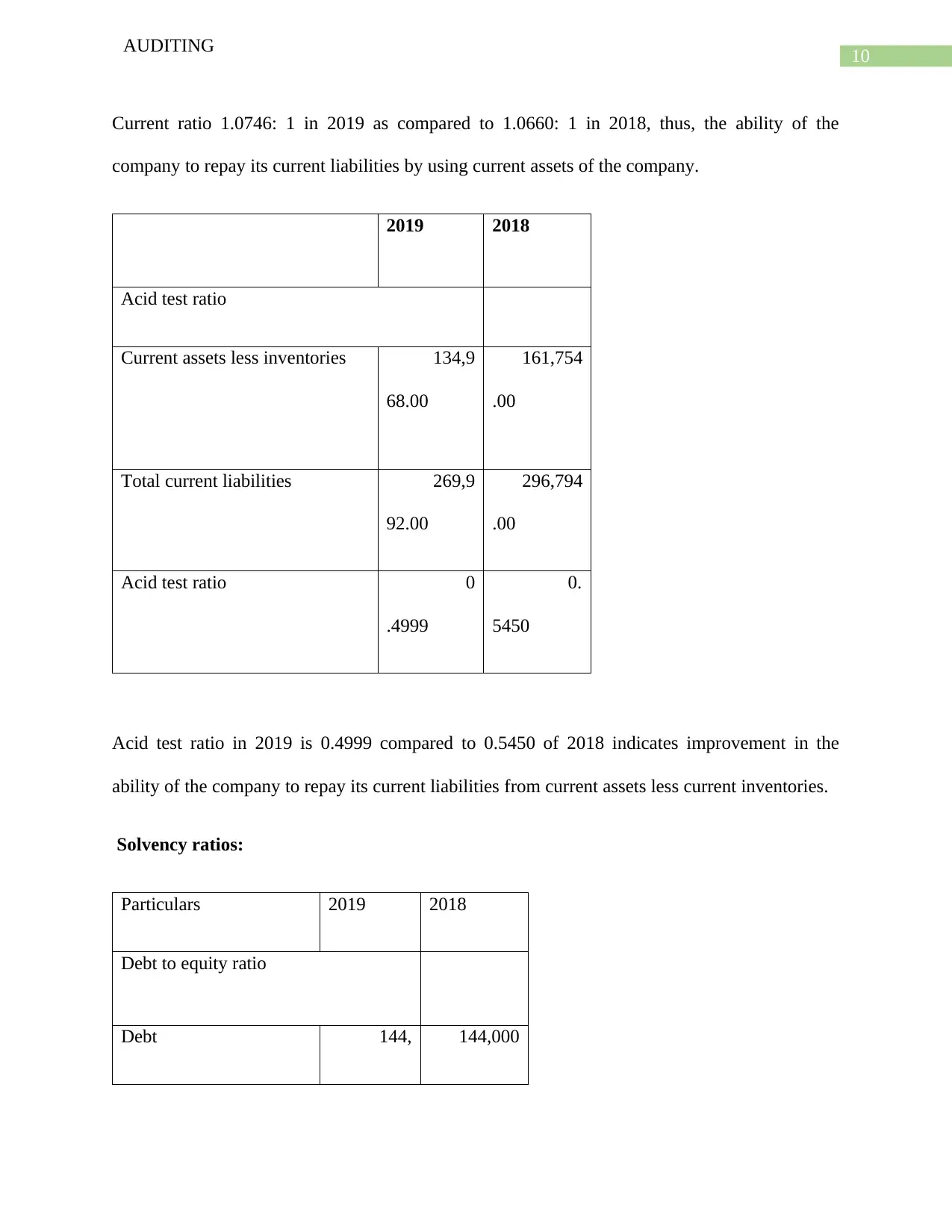
10
AUDITING
Current ratio 1.0746: 1 in 2019 as compared to 1.0660: 1 in 2018, thus, the ability of the
company to repay its current liabilities by using current assets of the company.
2019 2018
Acid test ratio
Current assets less inventories 134,9
68.00
161,754
.00
Total current liabilities 269,9
92.00
296,794
.00
Acid test ratio 0
.4999
0.
5450
Acid test ratio in 2019 is 0.4999 compared to 0.5450 of 2018 indicates improvement in the
ability of the company to repay its current liabilities from current assets less current inventories.
Solvency ratios:
Particulars 2019 2018
Debt to equity ratio
Debt 144, 144,000
AUDITING
Current ratio 1.0746: 1 in 2019 as compared to 1.0660: 1 in 2018, thus, the ability of the
company to repay its current liabilities by using current assets of the company.
2019 2018
Acid test ratio
Current assets less inventories 134,9
68.00
161,754
.00
Total current liabilities 269,9
92.00
296,794
.00
Acid test ratio 0
.4999
0.
5450
Acid test ratio in 2019 is 0.4999 compared to 0.5450 of 2018 indicates improvement in the
ability of the company to repay its current liabilities from current assets less current inventories.
Solvency ratios:
Particulars 2019 2018
Debt to equity ratio
Debt 144, 144,000
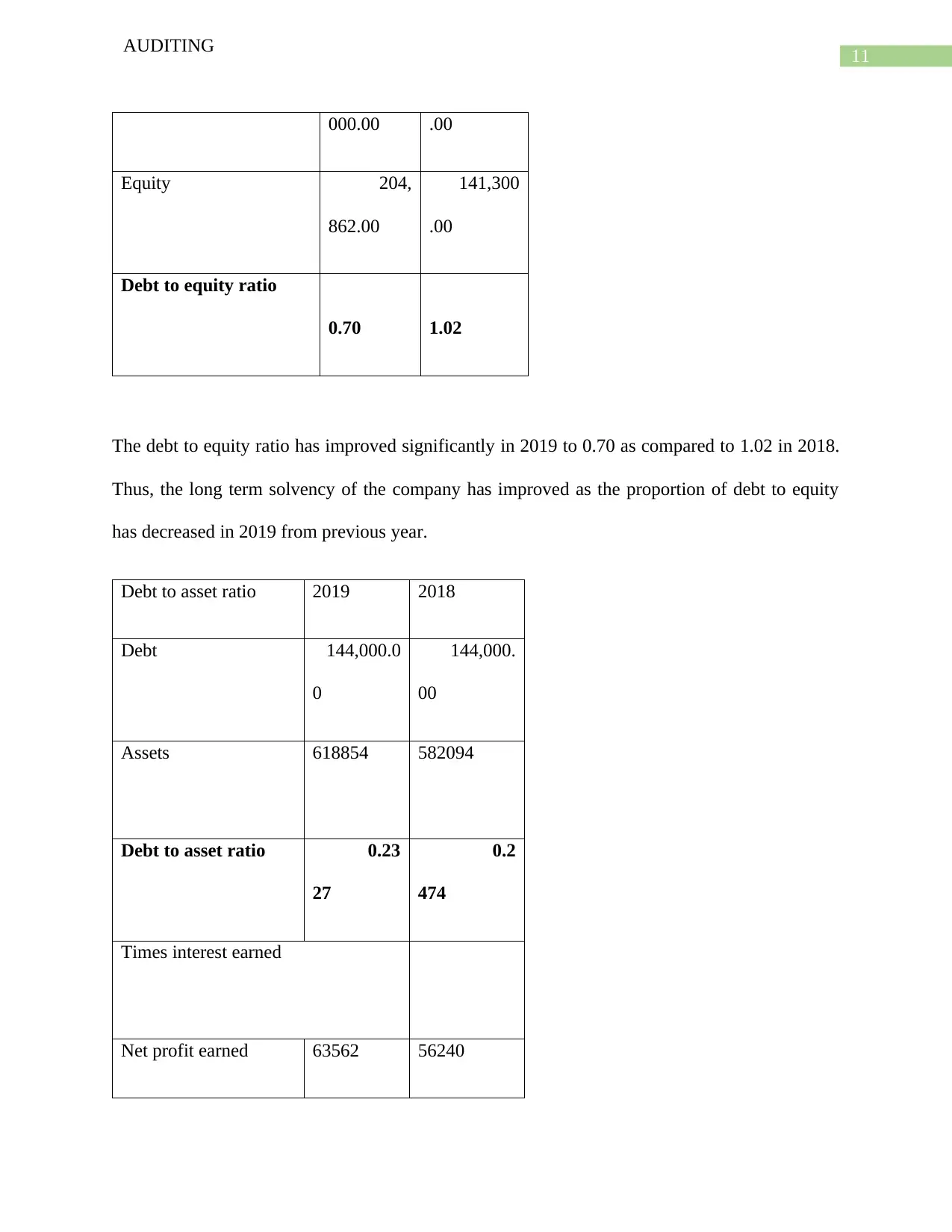
11
AUDITING
000.00 .00
Equity 204,
862.00
141,300
.00
Debt to equity ratio
0.70 1.02
The debt to equity ratio has improved significantly in 2019 to 0.70 as compared to 1.02 in 2018.
Thus, the long term solvency of the company has improved as the proportion of debt to equity
has decreased in 2019 from previous year.
Debt to asset ratio 2019 2018
Debt 144,000.0
0
144,000.
00
Assets 618854 582094
Debt to asset ratio 0.23
27
0.2
474
Times interest earned
Net profit earned 63562 56240
AUDITING
000.00 .00
Equity 204,
862.00
141,300
.00
Debt to equity ratio
0.70 1.02
The debt to equity ratio has improved significantly in 2019 to 0.70 as compared to 1.02 in 2018.
Thus, the long term solvency of the company has improved as the proportion of debt to equity
has decreased in 2019 from previous year.
Debt to asset ratio 2019 2018
Debt 144,000.0
0
144,000.
00
Assets 618854 582094
Debt to asset ratio 0.23
27
0.2
474
Times interest earned
Net profit earned 63562 56240
⊘ This is a preview!⊘
Do you want full access?
Subscribe today to unlock all pages.

Trusted by 1+ million students worldwide
1 out of 19
Related Documents
Your All-in-One AI-Powered Toolkit for Academic Success.
+13062052269
info@desklib.com
Available 24*7 on WhatsApp / Email
![[object Object]](/_next/static/media/star-bottom.7253800d.svg)
Unlock your academic potential
Copyright © 2020–2025 A2Z Services. All Rights Reserved. Developed and managed by ZUCOL.





